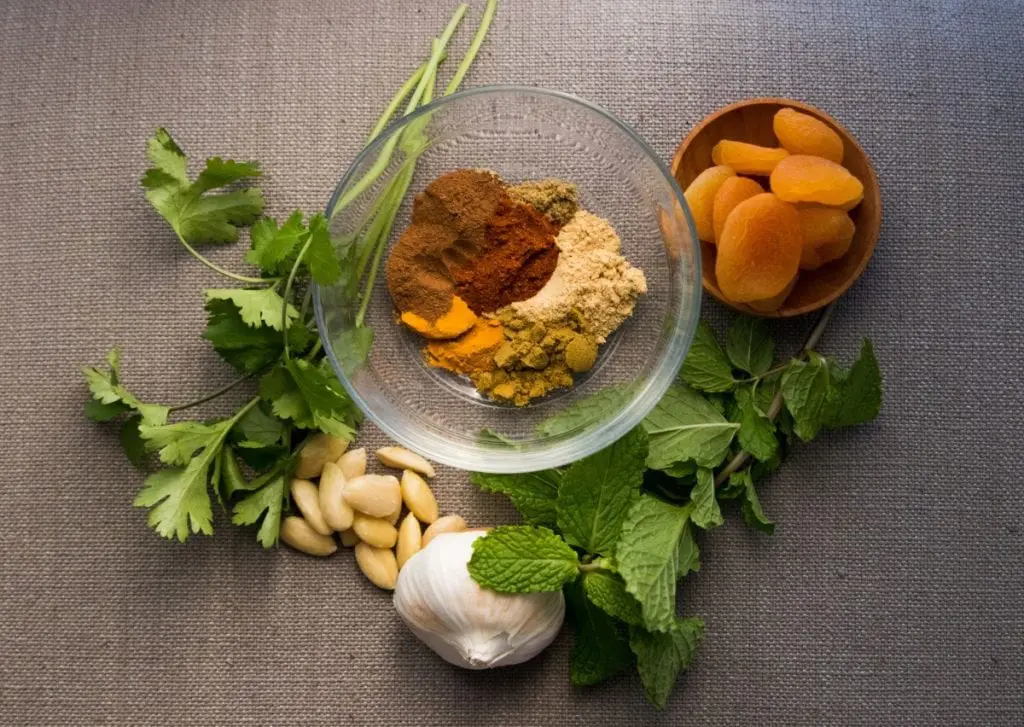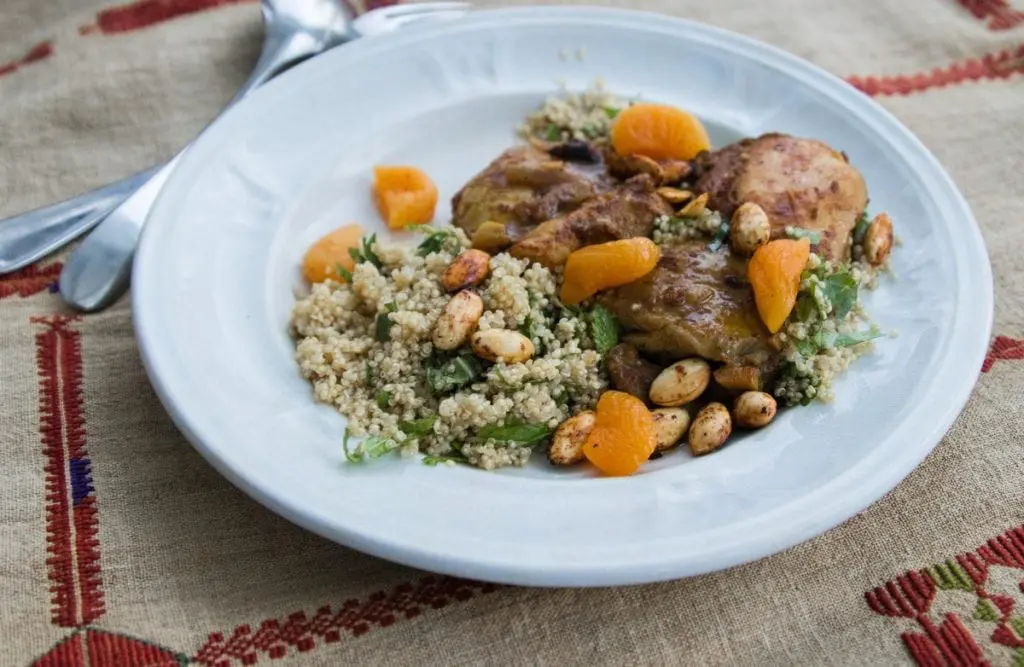The first thing I ate when I grew up was a tagine.
This is a 100 percent true fact. Before that, when I was fresh out of college and living, as we all lived, three-to-a-bedroom in some illegal sublet in New York City, weekends meant grabbing a street-cart pretzel en route to a party that was an exact replica of the one we’d attended the week before and the week before that and so on, going all the way back to campus.
In rooms packed as full as subway cars, we’d drink and drink, and shove a handful of chips into our mouths if we happened upon a bowl of them. After a year or two of this, the fancy ones among us began adding things like baked artichoke dip and hummus to our menus, and wearing cocktail dresses and painful heels at holiday time.
Eventually, we acquired our own apartments, or at least our own bedrooms; we made friends with people with lofts. We could breathe, in other words, and maybe find a sofa to sit on as the night wore on. But the basic pattern for a party remained unchanged. It was an event whose beating heart was a table crammed with cheap wine, beer and spirits, plus plastic Solo cups that might be clean or used; you took your chances.
And then my friend E hosted a dinner party and served tagine.
I had tasted tagine before — when I was a child, my mother’s best friend was a Morocco-phile. A dinner party, too, was not entirely new. Throughout college, I had attended and even hosted little get-togethers: four people and some spaghetti, that kind of thing. But E’s party was a real event. Twelve guests around a beautifully set table; food served in courses, and wines that had actually been chosen to go with each. It was a bold move, and it unnerved me. E was announcing that she felt entitled to assume an identity the rest of us were still too timid or oblivious to claim.

After that, we grew braver, however, and began hosting our own chic dinner parties. Before another year was out, we’d developed a knack for them, and for conjuring up all kinds of tagines — with olives or prunes, root vegetables or lamb. I must have eaten a dozen in my mid-20s. At the time, this whole passage felt seamless and natural, part of what I assumed was an inexorable progression from Budweiser to Barolo, Ruffles to risotto.
The other day, I made a chicken-almond-apricot tagine for my family. I was craving something warm and aromatic, satisfying but not rich. Everyone loved it. Peter declared it one of my “top six” all-time best dinners. (I didn’t ask where he got that number. Only six?)
Henry said, “Why haven’t you ever made this before?”
“I have,” I said, defensively.
“When?”
“All the time,” I said, and then realized, “um — before you were born.”
After that, I began wondering what had made me drop the tagine from my repertoire. Was it because tagine had been the quiche of its era? Was it because other, more “authentic” North African foods took its place? Was it because we all learned that tagine, like salsa, is a word that doesn’t mean what we thought it meant?

Yes, yes and yes! But more importantly, I think, tagines came to symbolize for me the things I did when I was trying to impersonate a grown-up, during those fragile, yearning years. Like so many styles that I adopted and discarded back then (thank heaven there was no Instagram to ,memorialize them), tagines became associated in my mind with a pretentious kind of sham-adulthood.
How silly. Actual adulthood turns out so very shammy, after all. Right now, as we emerge from the season when we’re most likely to wake up remembering those bygone Solo cups, it’s the perfect time to celebrate the everlasting art of growing up — and down, and sideways, too. It’s time, in other words, to play house by making an unforgettable tagine.
Chicken Tagine with Almonds and Apricots
Serves 4
1½ pounds boneless skinless chicken thighs
1 teaspoon each ground cinnamon, ginger and paprika
½ teaspoon each ground turmeric, cumin, coriander and black pepper
2 teaspoons salt
5 tablespoons olive oil
1 red onion, quartered lengthwise then sliced ¼-inch thick
5 garlic cloves, chopped
Several sprigs cilantro, parsley and mint (about 25 total)
1½ cups water
1/3 cup whole, blanched almonds (see note)
½ cup dried apricots, cut in half
½ cup orange juice
Couscous for serving
Harissa (optional) for serving
Preheat oven to 325 degrees. Place the chicken in a medium bowl. In a small dish, mix together the spices, 1 teaspoon salt and 1 tablespoon olive oil. Toss spice blend with the chicken until all the pieces are well coated. Set aside. (You can do this up to 3 hours before cooking; place the chicken in the refrigerator.)
In a Dutch oven (or clay tagine if you’re lucky enough to own one), heat 2 tablespoons olive oil over a medium flame. Add the sliced onion and ½ teaspoon salt, and saute until soft, mixing frequently, about 8 minutes. Add the garlic and cook, stirring, until softened, about 2 minutes. Add the reserved chicken, turning the pieces over until they are combined with the onion mixture. Add the water and bring to a simmer.
Meanwhile, remove the leaves from the parsley, mint and cilantro and set aside. Tie the stems together with kitchen twine, and add this bundle to the pot with the chicken and onions.
Once the chicken mixture begins to simmer, transfer the pot to the oven and reduce the heat to 275. Cook, uncovered, for 45 minute to 1 hour, until the chicken almost falls apart when you prod it with a fork.
While the chicken is cooking, heat the remaining 2 tablespoons olive oil in a frying pan and toast the blanched almonds until golden and just beginning to blister, 2 to 3 minutes. Place the apricots in a small saucepan, add the orange juice, and simmer over very low heat until the apricots are plump and soft. Ten minutes before serving, mix the apricots and reduced orange juice with the tagine.
Prepare couscous according to package directions. Chop the mint, parsley and cilantro leaves. Just before serving, toss herbs with finished couscous. Sprinkle almonds over tagine. Serve hot, with harissa on the side.
Note: If you can’t find blanched almonds, it’s easy to make your own: Bring a small saucepan of water to a boil, add raw almonds and simmer 1 minute; drain and rinse under cold water. When cool, gently squeeze the almonds and they’ll slip out of their skins.

